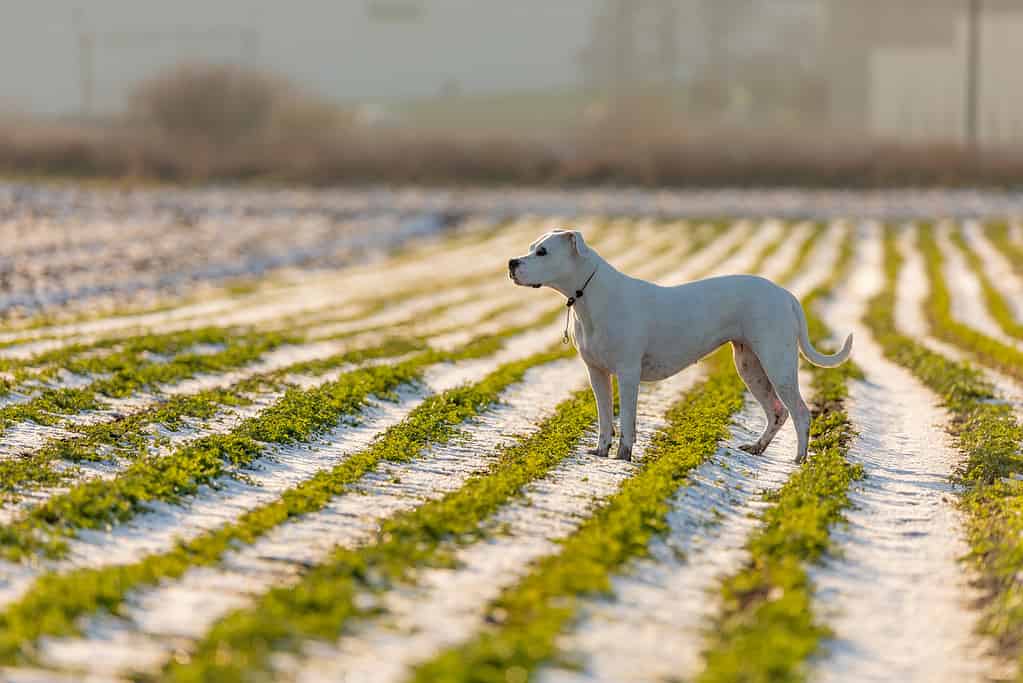Dogo Argentinos are huge, athletic dogs. You’d be forgiven for thinking these dogs were bred for guarding purposes. However, they were actually a hunting breed, bred to pursue large game like puma and wild boar. As you might imagine, that means these dogs are incredibly powerful.
If you decide to adopt a dogo Argentino, it’s important that you train them well. Because they are so large and powerful, these dogs can be potentially dangerous if not socialized or trained correctly.
Luckily, they aren’t terribly difficult to train. With some simple know-how, you can quickly have a well-trained dog on your hands.
1. Start Small
Like with all dogs, you should start with the basics. There are some fundamental commands that all dogs should know, such as “sit” and “stay.” Start teaching these commands as soon as your dog comes into your home. Whenever dogs are old enough to be with their mothers, they are plenty old enough to start training.
You can gradually work your way to more advanced commands. However, these dogs can be a bit slower to figure things out than others, as they tend to be very strong-willed. Therefore, it’s vital that you ensure the basic commands are mastered before you move on to more advanced commands.
Over-practice the easy stuff with this breed to ensure it is second nature.
2. Consistency

Try doing several short sessions and letting your dog rest in between. These dogs are simply not built for long periods of concentration.
©Leandro Comparin/iStock via Getty Images
It’s vital that you’re as consistent as possible when training your dogo Argentino. These canines thrive on consistency, and they can get very confused without it. If you have several people in your household, be sure they are all using the same commands the same way.
When possible, include others in your training, as well. Everyone should feel comfortable giving commands correctly, and taking part in training sessions is an easy way to ensure this is true.
3. Socialization
Yes, training your dogo Argentino cues is important. They should know how to sit and stay. However, socialization is the other part of the coin. It’s incredibly important to get your dog around tons of different people and places from an early age. This process helps ensure that your dog isn’t fearful of new things when they are older, which can lead to aggression. If you only do one thing with your puppy, socialize them!
We highly recommend puppy classes to get your dog socialized and start training. Group classes provide a safe area for your dog to interact with others, including dogs and people. However, you shouldn’t rely on group classes alone for socialization (as this may make your dog only socialize in the training location). Be sure to visit plenty of dog-friendly stores and parks, too.
4. Exercise
Dogo Argentinos are incredibly active and need lots of exercise. If you don’t meet their exercise needs, they can become bored and hyperactive. Often, this leads to destructive behaviors. When a bored dog tries to make its own fun, it usually isn’t what the owners want them to do.
It’s best to exercise your dog for a short time before you plan to train them. If your dog is tired, they’ll be more likely to listen well. This fact is especially true with puppies, who should be exercised for short periods several times a day.
No amount of training will help a dog that isn’t exercised properly. Before purchasing one of these dogs, ensure you can meet their exercise needs.
5. Patience

Dogo Argentinos need plenty of exercise to concentrate during training sessions. Be sure to exercise them about an hour or so before you begin training.
©Hanna Dymytrova-Kaihila/iStock via Getty Images
These dogs aren’t the most obedient and tend to be very independent. Therefore, it’s important that you are very patient with them and don’t try to push too hard too fast. It’s important that they completely understand one command before moving on, as they’re quick to turn off and go their own way. That’s one reason we recommend starting very young, it helps ensure that you have plenty of training time.
It also helps to break commands into very small pieces. While something may seem easy to understand from our perspective, a young dog doesn’t have access to language and doesn’t even know what training is. Therefore, even if it seems very easy for you, consider that it isn’t for your dog, and consider breaking it into smaller pieces.
6. Avoid Negative Reinforcement
You should always focus on positive reinforcement. This means always focusing on what your dog should do instead of what they shouldn’t. When they give the correct behavior, praise them for it. Positive reinforcement works much better in most cases.
The problem with negative reinforcement is that it tells the dog what not to do, but it doesn’t provide them with an alternative. Therefore, they may continue to do the bad behavior just because they don’t know what else to do.
Positive reinforcement gets around this by focusing on what you want your dog to do.
For instance, if you don’t want your dog to jump up on people, you may teach them to sit for pets instead. This provides them with a correct behavior, whole just scolding them into not jumping wouldn’t.
7. Consider Professional Classes
Professional classes can be very helpful for these dogs, as we touched on above. We recommend group classes instead of private ones, as group classes provide socialization and are cheaper. Most dogs will get more out of group classes than they will private classes unless there is something very specific they need to work on.
Private classes can be a good option for dogs that are dog-reactive and cannot be with other dogs. However, in this case, the goal should be to socialize the canine with other dogs (and people) so that they can partake in group classes.
Dogs with behavioral issues can also participate in private classes for their specific problem, though group classes should be considered, as well.
8. Routine

Adult dogs can often be fed twice a day, but you may need to feed your dogo puppy more often.
©Rafal Rutkowski/iStock via Getty Images
Establish a routine early on that includes feeding, exercise, and training. Your dog will often behave best when they know what to expect next. A dog that knows their walk is coming is more likely to be calm than one with no idea when their next exercise session will be. Dogo Argentinos do great with routine, as they tend to be creatures of habit.
Of course, this also helps ensure that you are meeting your dog’s needs. If you set up a routine that includes everything your dog requires in a day, you just have to follow the routine – not worry about whether your dog is hungry or needs to be walked.
9. Always End on a Positive Note
You should aim to always end training sessions on a positive note. Stop before you or your dog get annoyed or frustrated. Often, early training sessions need to be around 5 minutes or shorter, depending on the age of the dog. Sometimes, even giving a cue three to four times is enough to count it as a training session.
Once your dog gets used to the idea of training and expands their attention span, you can slowly work up to 10 minutes. However, this is the maximum length of any training session a dogo Argentino should be asked to do. Any longer than that, your dog will surely get annoyed and frustrated.
Remember, these dogs aren’t the most obedient, so training typically isn’t as fast as it is for other breeds. Don’t expect to get that much done in a single session. You’ll make far more progress doing several short sessions throughout the day than one long session.
Aim to keep training sessions fun, too. The more fun your dog has, the longer they’ll be able to pay attention.
11. Have Fun!
Of course, you should have fun, too. If you make training sessions a chore, you’re less likely to do them. Consistent sessions are very important for this breed, so it’s vital that you keep up your training schedule to see any progress.
Plus, if you’re dragging through a training session, your dog will pick up on it. Dogs are very good at reading human body language and figuring out our emotions. If you don’t want to be there, your dog won’t want to be there, either.
The photo featured at the top of this post is © iStock.com/Gerdzhikov
Ready to discover the top 10 cutest dog breeds in the entire world?
How about the fastest dogs, the largest dogs and those that are -- quite frankly -- just the kindest dogs on the planet? Each day, AZ Animals sends out lists just like this to our thousands of email subscribers. And the best part? It's FREE. Join today by entering your email below.
Thank you for reading! Have some feedback for us? Contact the AZ Animals editorial team.







